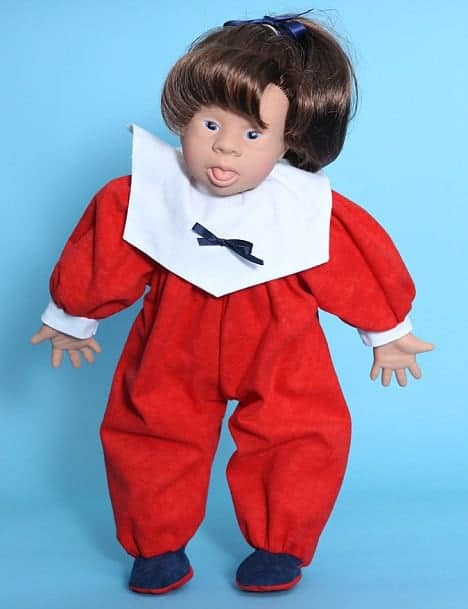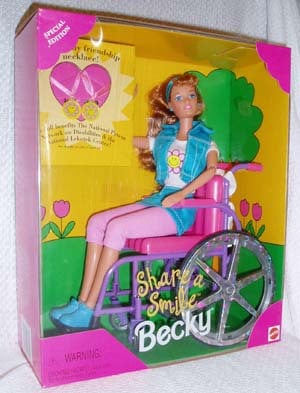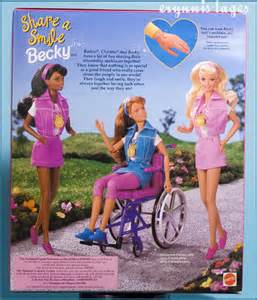Update Dec 30 2013. A reader haas informed us that there is a disabled pack for Journey Girls available at Toys R Us and Amazon. Someone’s thought of everything!

…………………………………………………………………………………………………………………………………………………………………………………………………………………………………………………………………………………..
Although many less able children may have asked for a Barbie this Christmas, it’s unlikely that any will be expecting to find a Barbie with a wheelchair under the tree. In fact, it’s hard to find any toys which represent less able children. They simply don’t exist…. anymore. However, in the nineties Mattel did produce a Wheelchair Barbie, only for the dolls quickly disappear.
This is the story of Share A Smile Becky, the wheelchair Barbie created over fifteen years ago, only to almost completely disappear just a few years later. Since then there have been no disabled Barbies and, other than some controversial Down’s syndrome dolls and custom made toys, extremely few less able toys at all.
In many other ways the Barbie brand has opened itself up towards diversity over the years. Alongside classic blonde Barbie there is now a brunette Barbie, ginger Barbie, African American Barbie (yes, Barbie is always American) and many more. But strangely, in spite of all this, there is only one Barbie without working legs: Mermaid Barbie. In other words, there is no less able bodied Barbie.

The wheelchair using Barbie doll was released in 1997. She was not a version of Barbie herself but another character, Wheelchair Becky, a doll designed to be a friend of Barbie. There were some teething problems with the very first model which were amusing, as long as you hadn’t bought it. For instance, ironically, the original version of Wheelchair Becky couldn’t fit her wheelchair into the Barbie Dream House and her hair would get caught up in the wheels of her chair. Even in the perfect world of Barbie, accessibility was a persistent and everyday problem.
The dolls were rejigged, given shorter hair, a different wheelchair and new clothes, then re-branded as Share A Smile Becky. This new model flew off the shelves, selling out in two weeks. Wheelchair Becky, with her contemporary style and pink and purple wheelchair became a positive role model and showed that less able people can still be fashionable and fun. She was a great example of a toy that less able kids could relate to, although some critics felt that it was a way of pigeon holing them as wheelchair users.

Oddly, after the success of the second wheelchair Becky, Mattel never made another wheelchair using Barbie. The dolls pretty much vanished and nobody seems to know why. Many people have alleged that Mattel decided to stop because producing more wheelchair dolls would require changing all of the other products that Barbie customers bought to go with their dolls. Despite the changes made after the early access problems, Becky still couldn’t use all of the extra Barbie related products – the houses, the cars, the horses etc. Either they had to be adapted or she had to go, the story went.
It was argued that Mattel decided that if they would only be able to sell one Becky doll per customer, with no added extras, it was better for their bottom line to take her off the shelves. The alternative was to change every single other item in the Barbie catalogue so that Becky would be able to use them too. Basically, the theory (and it is just a theory) was that Mattel decided that rather than change the structure of existing products, it would be easier to just ignore disabled Becky. A company ignoring the needs of the less able because it’s less effort than adapting for them – does that thought process sound familiar to anyone?
Mattel, who actually have a good record for promoting diversity, have understandably denied that this is the reason behind the current lack of wheelchair companions for Barbie. It’s worth noting that there was a polarised reaction to Share A Smile Becky, as there has been to other less able dolls, which may be reason enough for the company not to want to continuing producing them.
We’ll probably never know exactly why they stopped making wheelchair using Barbies but we do have a more concrete reason from Mattel than was given at the time. In 2006, an American mother went in search of the disabled Barbie. Incredibly, she managed to speak to the people right at the top of the hierarchy at Mattel but never learned why they never made more wheelchair-using dolls. She was however, generously given a Share A Smile Becky doll, sent to her from the archives.
Sara Rosales, vice president of communications for Mattel Brands at the time, said that Mattel only ever planned the Becky doll as a temporary part of its 1997 line and had never proposed to produce it since then. She added that the company might create another wheelchair-using doll in the future but has no definite plans to do so. It’s been a long time since 1997 so you wonder if they ever will.
We will have to wait and see if another Wheelchair Barbie is ever released. It seems like a good idea to promote inclusion and self confidence through the toys that kids play with. Some brands, particularly Playmobil, continue to represent children with disabilities in their toy range but beyond them, less able toy characters are few and far between.
There are some Share A Smile Beckys out there, mostly on Ebay, but there are not very many of them. Here’s hoping that there will be a new, modern version of the less able Barbie next Christmas!

I am surprised Mattel don’t sell a wheelchair and other mobility aids as a separate extra that all their Barbie dolls can use. Journey Girls are one toy line that do this and sell a purple Wheelchair and Crutch set.
There were actually two other Beckys produced but they are just as equally rare. One was for the Paralympics and the other had her as a School Photographer.
I have the Paralympic Becky. As a disabled female I was happy to finally see a doll I could relate to.
I remember seeing this doll when it first came out as a kid at the Barbie store in the Mall of America. Even though I myself do not have a disability, I loved this doll. She was different, and still fashionably Barbie, with a pink wheelchair of course. It represented reality and not just Barbie’s typical gig of the month.
I think that goes to show that all children would enjoy this doll. Mattel is really missing out on a potential market here. Such a shame.
I Was given Share a smile Becky as a gift by Santa at a MDA Christmas party. I Didn’t know about Becky until then and it was that day that changed my life. Every little girl wants to be like Barbie and here I had barbies best friend who was in a wheelchair just like me. I Felt like I could do anything in the whole world. Thanks to that moment, I nev let anyone tell me I can’t do something.
I’m Now a mother to a beautiful little girl when I was told that I would never have kids, and I live on my own. What more could a girl want?
That isn’t fair because they sold a Barbie doll that had no hair to girls suffering from illnesses like cancer and there aren’t just ill girls out there, there are disabled girls out there. The share a Smile Becky doll was a great image but since it sold out so quickly and Mattel never made any more Barbie dolls with wheelchairs and that’s not right.
Hi-I make over dolls, like barbie and Bratz. I repaint them to look more like real kids. Anyway a new company called “Toy Like Me” has just launched a line of dolls that represent every kind of kid. For the month of May many doll artists from all over the world will be creating a special doll to promote Toy Like Me and these new dolls. I will be making one as well, in fact I plan to do one in a wheelchair. The event page is here if you want to follow along. https://www.facebook.com/events/836322876441067/
I was a little girl who always wanted to see a doll that looked like me and Becky was the only doll I ever saw. I thought Mattel was waking up to inclusion.
[…] the idea of people wanting to see themselves represented in the world around them, to be able to get Share-a-Smile Becky’s wheelchair inside the damn Barbie Dream House, it’s just never felt like it applied to me. Representation for my invisible pain would be, um, […]
I was given Share a Smile Becky when I was five year old (not so coincidentally right as my baby sister was learning to steer her hot pink wheelchair for the first time)
24 years later, I still have her!
But I have to point out, she wasn’t the only wheelchair-using Barbie my sisters and I owned.
My sister had a completely different, blonde doll with a red and silver wheelchair. I think she was a school photographer? I seem to recall her carrying a cardboard yearbook.
At some point, both of the plastic wheelchairs had broken (ten years and moving states will do that), so we had, if I remember correctly, kind of frankensteined Becky’s sparkly wheels onto the Other Barbie’s red chair lol
I do really wish you’d say “disabled,” not “less abled.” People aren’t “less” because we’re disabled.
Can’t win I’m afraid as all terminology has controversy. We now say ‘disabled people’
My then teenage daughter bought herself a “Paralympic Becky”, a friend of Barbie’s, as a souvenir of the 2000 Olympics here is Sydney. She was into collecting dolls at the time but wanted something different and inclusive, even though my daughter and no one we are close to had a disability. We still have her (well I do at my house), and she is still in her box.